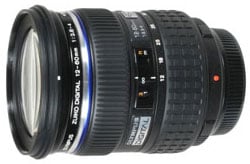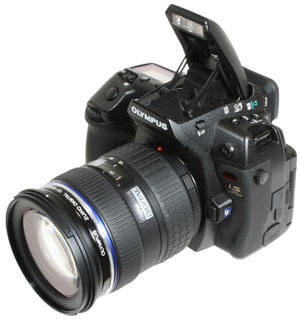Olympus E-3
-
-
Written by Gordon Laing
Olympus E-3 verdict
It comes as no surprise to learn the Olympus E-3 is by far the most powerful Four Thirds DSLR to date, and one that’s more than a worthy successor to the original E-1. After all, Olympus had four and a half years between the launch of the E-1 and its long-awaited successor, giving the company ample time to address the issues of the standard, along with producing a compelling rival to the latest semi-professional models from Canon, Nikon and Sony.
There’s certainly a lot to like about the E-3. The build quality is superb and the splash-proof construction very reassuring. The fully-articulated monitor gives you enormous compositional flexibility when shooting in Live View and puts fixed monitors to shame. The Image Stabilisation is the most effective of all any in-camera system we’ve tested, giving us an impressive four to five stops of compensation when tested at an equivalent focal length of 120mm. And while the SSWF anti-dust system may not be infallible, it remains one of the best around.
 |
The degree of customisation is comprehensive, the operating speed (especially with UDMA Compact Flash cards) is very snappy, and the in-camera JPEG image quality very good. And perhaps best of all is having access to some of the highest quality lenses we’ve tested, including the superb Zuiko Digital 12-60mm SWD. Many photographers buy-into Four Thirds just to use lenses like these.
Then there’s the two things we thought we’d never say about a Four Thirds DSLR. First, the viewfinder is actually a joy to use: large, bright and an inspiration for using the 4:3 format. Secondly, the autofocus (with the 12-60mm SWD lens anyway) can be quick, really quick.
But of course it’s not all good news. Control systems and ergonomics are always subjective but we found the E-3’s buttons were small and sometimes illogically placed, while pressing some and turning the dials at the same time wasn’t always a comfortable manoeuvre. The AF system could well be the World’s fastest under some conditions, but we found too many times when it struggled to lock onto moving subjects when rival semi-pro bodies simply got on with it.
Then there’s the bigger issue of the format itself. If we’re being honest, 10 Megapixels is probably sufficient for most of us (and we’ve seen some impressive-looking big prints from the E-3), but it’s important to know there’s a future path for your investment in lenses. It’s hard to imagine there won’t be a higher resolution Four Thirds body in the future, but how close are we to the sensible limit of its sensor area right now?
The E-3’s sensor certainly performs well up to 800 ISO, but there’s not a great deal of headroom in those files for tonal adjustment and at higher sensitivities, there are better alternatives for the money. And remember Canon and Nikon today, with Sony in the near future, have full-frame options for their compatible lenses – that’s a big upgrade in sensor area and light gathering power which Four Thirds can only dream of.
And now we’ve mentioned those brands in name, how do their semi-pro models compare?
Compared to Canon EOS 40D
 |
Canon’s semi-pro EOS 40D comes in at around two thirds the price of the E-3 body while sharing the same 10 Megapixel resolution (albeit in a different aspect ratio), and sporting a bigger (albeit fixed) 3in screen, slightly quicker continuous shooting, supplied PC / Mac remote control software which includes previewing the live image on your monitor, and optional Wifi connectivity. It also supports 14-bit A to D conversion and 14 bit data in the RAW files, which with the slightly bigger sensor area gives greater latitude for tonal adjustments.
In the E-3’s favour are built-in Image Stabilisation, a flip-out screen, better anti-dust systems, greater claims of weatherproofing and a viewfinder with 100% coverage. The built-in IS is an enviable feature, although you won’t see the effect through the viewfinder. The E-3’s flexible screen also makes the Live View more practical when you’re out shooting, although studio-based or technical photographers may prefer the 40D’s free PC remote control software with Live View and focusing on your monitor. There’s a lot to weigh-up, but one thing’s for certain: the EOS 40D is priced very competitively, especially when you take Canon’s regular rebates into consideration. See our Canon EOS 40D review for more details.
Compared to Nikon D300
 |
The Nikon D300 costs roughly the same as the E-3, so is the natural choice for a direct comparison. The D300 is certainly a feature-packed camera and in its favour are two extra Megapixels, a large and wonderfully detailed 3in VGA screen (albeit fixed), slightly quicker continuous shooting (which can be boosted further with the optional battery grip), an HDMI port for connecting to an HDTV, a built-in Intervalometer, accurate feedback of battery life remaining, optional Wifi facilities, and in our subjective view, superior ergonomics. Like the EOS 40D, it also supports 14 bit RAW files which with the slightly bigger sensor area gives greater latitude for tonal adjustments.
In the E-3’s favour are again built-in Image Stabilisation, a flip-out screen, better anti-dust systems and greater claims of weatherproofing. As before, even though you can’t see the effect through the optical viewfinder, the built-in IS is an enviable feature, while the flexible screen makes the Live View more practical when you’re out shooting. This time the D300 matches the E-3’s 100% viewfinder coverage while additionally offering on-demand LCD grid lines, but Nikon doesn’t offer a live histogram in Live View.
Unless you have an existing investment in lenses, this is an even tougher one to weigh-up, as both are extremely powerful and feature-packed cameras. See our Nikon D300 review for more details.
Compared to Sony Alpha DSLR-A700
 |
The Sony Alpha A700 is the company’s first semi-pro DSLR and one with some compelling features which typically comes in at just over two thirds the price of the E-3. In the Sony’s favour beyond the lower price are two extra Megapixels, a large and wonderfully detailed 3in VGA screen (albeit fixed), an HDMI port for connecting to an HDTV and accurate feedback of battery life remaining. It’s large buttons are also better-suited to gloved-operation, and while the RAW files are also 12-bit, the larger sensor area is an advantage.
In the E-3’s favour are Live View with a flip-out screen, better anti-dust systems, an upper LCD information screen, 100% viewfinder coverage and greater claims of weatherproofing. Both cameras have the same 5fps continuous shooting rate and also sport built-in anti-shake facilities, although in our tests the E-3’s stabilisation was more effective.
Again it’s a case of weighing up the features against the price and personal handling. See our Sony Alpha DSLR-A700 review for more details.
Olympus E-3 final verdict
If you’re an existing Four Thirds owner looking for a top-end body, the E-3 is a fantastic choice, especially if you’re coming from the original E-1 – it’s a significant upgrade in every respect. It’ll also appeal to owners of other E-series cameras looking for an upgrade, and even though the resolution is no greater than the E-410 and E-510, there’s plenty of other benefits to get excited about.
The bigger questions though are for those buying into a new camera system from scratch, or considering a switch from a rival system. Does the E-3 have what it takes to beat the rivals above, or even persuade an existing Canon, Nikon or Sony owner to trade?
 |
As described in the comparisons above, the E-3 certainly has a lot going for it, including several unique aspects. There’s built-in anti-shake which proves highly effective; the anti-dust system is the best around; it has the greatest claims of weatherproofing for the semi-pro models currently available; there’s a fully-articulated screen which makes Live View really useful; and it has all the usual features you’d expect from a semi-pro camera including fast continuous shooting, a PC Sync socket, battery grip and broad customisation to name a few.
At this point, many Four Thirds reviews follow a similar conclusion along the lines that the camera’s certainly feature-packed, but the standard itself has some concerns. The viewfinder and AF are two usual scapegoats, but with the E-3, Olympus has significantly improved both. The tunnel-vision of earlier Four Thirds viewfinders has been upgraded to a large and bright experience that inspires you to use the 4:3 aspect ratio. The older basic 3-point AF system has been replaced by a new 11-point system which with the right lens and conditions can perform extremely quickly.
So what’s left to criticise? Well the one thing Olympus couldn’t do was increase the sensor area, and this will remain an Achilles heel for the Four Thirds standard. The E-3’s images can undoubtedly look great, but as mentioned earlier, there’s already not much latitude for tonal adjustments and if you shoot at high sensitivities, there’s better choices out there.
And that’s where many editorials finish, but when evaluating these cameras, you have to seriously ask yourself how often do you shoot at 800 ISO and above? If the answer is regularly, then we’d say there are better alternatives, especially if you go full-frame. But if you predominantly shoot at lower sensitivities, then the E-3 becomes a serious contender.
Indeed rather than always viewing the Four Thirds sensor size as a disadvantage, instead consider the access you’ll have to a range of superb quality lenses. Take a look at our results page to see how the E-3 with the Zuiko Digital 12-60mm SWD compares against the Nikon D300 with the DX 17-55mm f2.8. Both are premium bodies with premium lenses, but one is clearly outperforming the other. So if you mostly shoot under those kind of conditions, which system would you prefer?
Ultimately there isn’t a single perfect semi-pro DSLR when you consider the entire system. Each has its pros and cons and is suited to different styles of photography. So it’s more important than ever to think very carefully about the kind of images you’re intending to take, compare the features and of course pick up each camera in person to see how it looks, feels and even sounds to you.
As for the E-3, we’d say it’s not the camera for you if you regularly shoot at 800 ISO or above, and like to push the tonal range of your RAW files. Equally, while the E-3’s AF system has enjoyed a impressive upgrade which can be supremely quick under the right conditions, we found its tracking of moving subjects less reliable than Canon and Nikon’s semi-pro models – so we’d say if you’re predominantly shooting sports or action, there’s better alternatives. And while 10 Megapixels is probably enough for most of us, there’ll always be those who need, or simply just desire higher resolutions and you have to ask how many more pixels can be squeezed onto this sensor in the future.
But if you don’t fall into any of these camps, the E-3 is a highly compelling option with its tough, splash-proof construction, effective anti-shake and anti-dust, flexible monitor, great quality images and access to some of the best lenses around right now. Caveats aside, if you’re in the market for a quality semi-pro DSLR, you should definitely add the E-3 to your shortlist.
Good points Bad points |  Scores | |||
Build quality: Image quality: Handling: Specification: Value:
Overall: |
19 / 20 17 / 20 18 / 20 19 / 20 15 / 20
88% | |||



